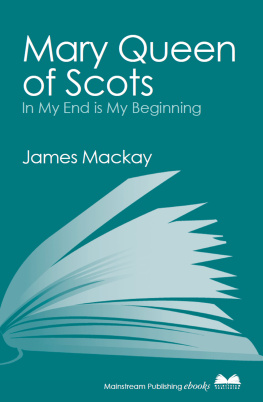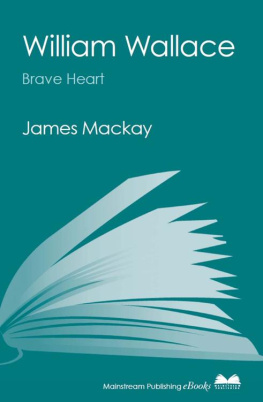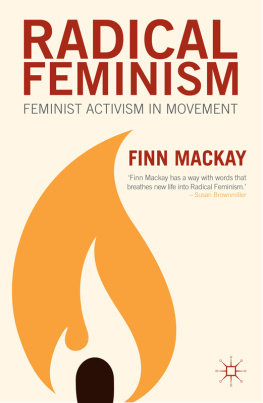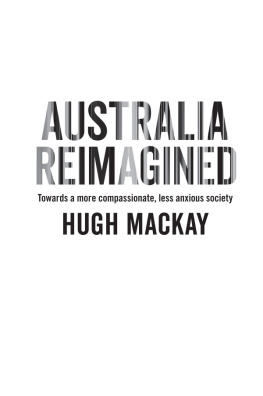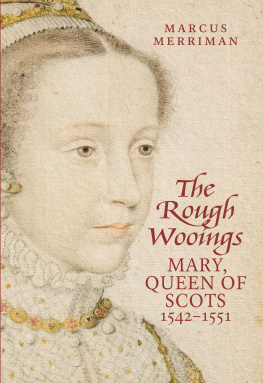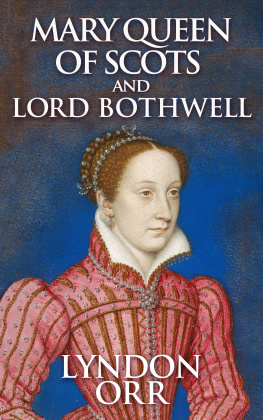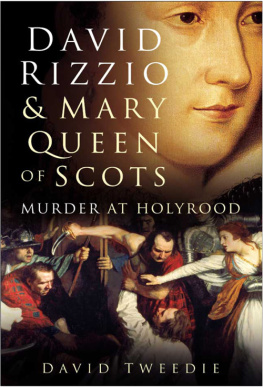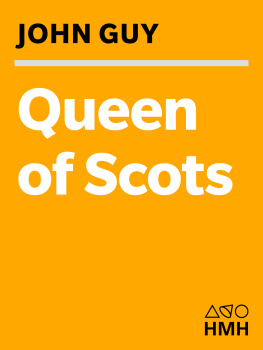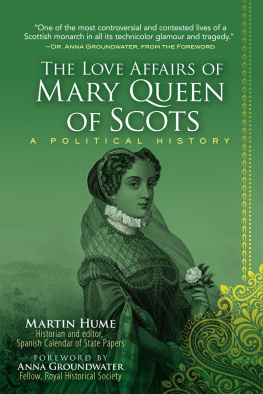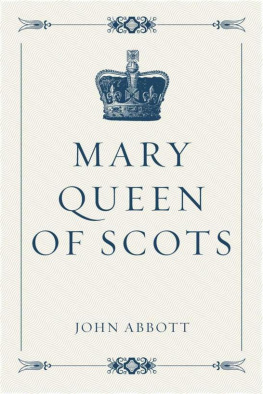CONTENTS
Mary Queen of Scots
In My End is My Beginning
James Mackay

For Helen
ALSO BY THE SAME AUTHOR
Burns: A Biography of Robert Burns
Vagabond of Verse: A Biography of Robert Service
William Wallace: Brave Heart
The Eye Who Never Slept: A Life of Allan Pinkerton
Michael Collins: A Life
Sounds Out of Silence: A Life of Alexander Graham Bell
Little Boss: A Life of Andrew Carnegie
The Man Who Invented Himself: A Life of Sir Thomas Lipton
I Have Not Yet Begun to Fight: A Life of John Paul Jones
INTRODUCTION
In his memoirs, The Way the Wind Blows, Lord Home recalled an evening with Andrei Gromyko (the then Soviet foreign minister) and his wife at the play Vivat Regina in London. At the end of the second act, in which David Riccio was brutally murdered in the presence of his queen, Gromyko turned to Alec Douglas-Home and said: Do I not find myself in very dangerous company? When Lord Home queried this, Gromyko replied: Did I not hear Mary Stewart say, as the dagger went into Riccio, And you, Douglas, too? In the real-life drama of the Scottish queen there was a Lord Hume (sic) and Douglases aplenty. The prevalence of certain names, recurring over the centuries, is one of the few things that give stability and coherence to the aurora borealis of Scottish history. This is immediately countered by the permutations and combinations of alliances, factions and cliques, ever-changing, as traditional enemies draw together for mutual interest, and just as rapidly fall apart again. This factor is vividly and most forcefully exposed by the late Professor Gordon Donaldson in his brilliant study All the Queens Men: Power and Politics in Mary Stewarts Scotland (1983) which unravels the tangled knot of politics, religion and family which bedevilled Mary at every turn.
Scottish history was never more kaleidoscopic than it was during the four and a half decades of the life of Mary Queen of Scots, nominally queen from the age of six days until her execution in 1587, but in fact monarch for little more than six years (156167) and only in real command of her destiny for a very few months at that. The first nineteen years of her life were mostly spent far from her own kingdom, when she was being groomed at the French court for eventual marriage to the Dauphin; and the last nineteen years were spent in captivity in England. The period of her personal rule was not only brief, but beset by problems and circumstances largely outside her control. Few people would share the view of Dr Jenny Wormald that Mary was the worst, most incompetent ruler that Scotland ever had. In justifying this sweeping condemnation she has produced a book which is worth reading if only as a powerful corrective to so much of the earlier hagiography dripping with uncritical adulation of the saintly martyr for her faith.
The volume of literature devoted to Mary is truly prodigious. Lady Antonia Fraser, the author of the best-known biography in modern times (1969), noted that the Collection Blis in the Bibliothque Nationale in Paris contained about 20,000 books that touched on the subject. Of these, probably more than a thousand are biographies, novels or plays dealing with her life. It would appear that Lady Antonia Fraser and I have both consulted the same sources, including T.F Hendersons two-volume biography of 1905, plus innumerable other books. I would agree with Lady Antonia that all historical biographers are mutually dependent on their predecessors, and I am unstinting in my admiration of her towering scholarship. It might have been thought that Lady Antonias monumental volume, published almost thirty years ago, would be the last word on the subject, but the ink was scarcely dry when Gordon Donaldsons First Trial of Mary Queen of Scots appeared, followed by the same authors Mary Queen of Scots (1974).
To Professor Donaldson, Mary was an intelligent, able and energetic queen, with a sense of religious tolerance that was beyond the grasp of her contemporaries, guilty not of crimes but lacking in judgment at times, leading to a downfall unfortunate for being on the whole undeserved. In 1988 Dr Jenny Wormald produced Mary Queen of Scots: A Study in Failure which painted an unrelievedly black picture of Mary as negligent, irresponsible and incompetent at best; at worst guilty of complicity in the murder of Darnley. The previous year, the quatercentenary of Marys execution, witnessed a spate of publications, including Rosalind Marshalls Queen of Scots, D. Breezes A Queens Progress and Ian Cowans Mary Queen of Scots. Even David and Judy Steel got in on the act with Mary Stuarts Scotland, none of which shed fresh light on the subject. The one really bright spot in this Marian Year was the appearance of Margaret Sandersons Mary Stewarts People, a fascinating collection of essays on a broad spectrum of people, from a humble tailor to Cardinal Beatons mistress Marion Ogilvy, who lived during Marys reign.
Most recently there has been Mary Queen of Scots: The Crucial Years by the Duke of Hamilton (1991). Apart from the unique qualification of being an actual descendant of Queen Mary, the Duke advanced our understanding of his tragic ancestress by concentrating on the two years between her marriage to Darnley and her enforced abdication, and backed this with a hundred biographical sketches of the chief personalities of Marys reign. I have to admit that, of all the recent writings on Mary, this has been for me by far the most useful, not only distinguishing persons of the same or very similar names but also pinpointing what they were doing, and with whom they were allied, at any given juncture. While many other books include family trees, this book thoughtfully included charts and diagrams analysing, for example, the minority reigns that so often bedevilled the Stewart dynasty, and particularly the overlapping lists of those complicit in the murders of Riccio and Darnley. For a more detailed analysis of the wheeling and dealing, the power-play and the positively Byzantine background to Marys personal rule, Gordon Donaldsons All the Queens Men, previously referred to, is essential reading.
Reflecting the much more objective approach to Scottish history in recent years, as the sectarian propaganda and political polemics have given way to a more systematic, scientific examination of the facts, a clearer picture of Mary is beginning to emerge. Hand in hand with this process has been a re-appraisal of some of the other major actors in the drama, notably a volume in the Studies in British History series, William Blakes masterly exposition of William Maitland of Lethington (1990), and Caroline Binghams biography of Darnley (1995) which re-examines the crucial years of 156567 from the standpoint of the principal victim of Kirk o Field. To all of these writers, and very many more, especially those scholars who concentrated on specific aspects such as the Casket Letters and the Kirk o Field affair, I owe an immense debt. One could, in fact, produce a volume many times the size of this book dealing with the diametrically opposing opinions, attitudes and interpretations of Marys life and times, but for a concise survey of the extraordinary scope of Marian literature I can commend Ian Cowans Enigma of Mary Stuart (1971).
I make no apology for offering this fresh look at Mary. Writing in the aftermath of the devolution debate and referendum, I have been forcibly struck by the application of so much that was happening in the 1560s to the present time. I had not fully appreciated, for example, the extent to which Queen Elizabeth, both personally and through her ministers, agents and ambassadors, manipulated and controlled the affairs of Scotland. Despite Schiller and Hollywood, Mary and Elizabeth never met; yet their lives were inextricably woven together. Essentially this was a power struggle between two of the outstanding figures in British history. The fact that they were both women adds a feminist dimension: the one married only to her country and the other married all too often to men who failed her.
Next page
